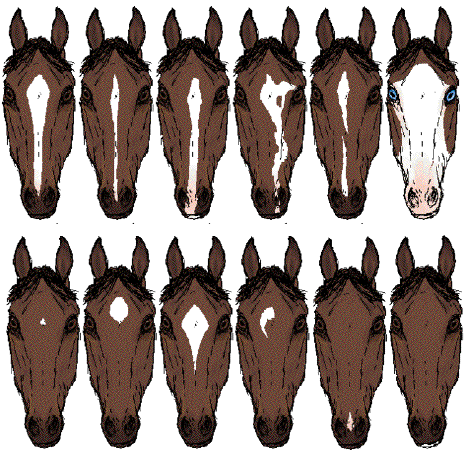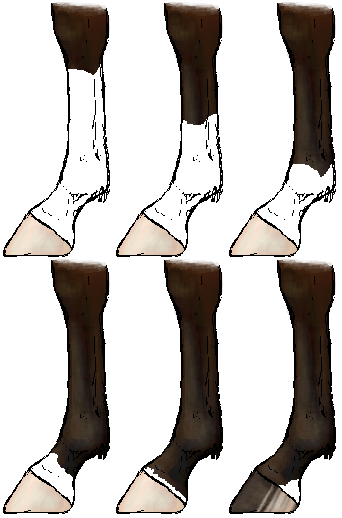Markings on horses usually are distinctive white areas on an otherwise dark base coat color. Most horses have some markings, and they help to identify the horse.
Facial markings:
Facial markings are usually described by shape and location. There may be more than one distinct facial marking and if so, will be named separately.
Occasionally, when a white marking extends over an eye, that eye may be blue instead of brown, though this is not consistently seen in all cases.
Common facial markings are:

Top row, L-R: Blaze, Stripe, Stripe (or thin blaze) and snip, Irregular blaze, Interrupted stripe, bald face. Bottom row, L-R: Faint star, Star, Star and strip, irregular star, snip, lip marking
Leg markings:
Leg markings are usually described by the highest point of the horse's leg that is covered by white.
As a general rule, the horse's hoof beneath a white marking at the coronary line will also be light-colored ("white").
If a horse has a partial marking or ermine spots at the coronary band, the hoof may be both dark and light, corresponding with the hair coat immediately above.
Where the Leopard gene is present, the hoof may be striped even if markings are not visible at the coronary band.
From tallest to shortest, common leg markings are:

Top row, L-R: Stocking, Sock or Boot, Fetlock or Sock. Bottom row, L-R: Pastern, Coronet, Partial Pastern
On a gray horse, markings visible at birth may become hidden as the horse turns white with age, but markings can still be determined by trimming the horse's hair closely, then wetting down the coat to see where there is pink skin and black skin under the hair.
Facial markings:
Facial markings are usually described by shape and location. There may be more than one distinct facial marking and if so, will be named separately.
Occasionally, when a white marking extends over an eye, that eye may be blue instead of brown, though this is not consistently seen in all cases.
Common facial markings are:
- Blaze: a wide white stripe down the middle of the face.
- Strip, stripe, or race: a narrow white stripe down the middle of the face.
- Bald Face: a very wide blaze, extending to or past the eyes. Some, but not all, bald faced horses also have blue eyes.
- Star: a white marking between or above the eyes. If a stripe or blaze is present, a star must be significantly wider than the vertical marking to be designated separately.
- Snip: a white marking on the muzzle, between the nostrils.
Additional terms used to describe facial markings include the following:
- Faint: A small, yet permanent marking that usually consists of white hairs without any underlying pink skin.
- Interrupted: A marking, usually a strip or blaze, that is broken and not solid for the entire length of the face.
- Connected: Occasionally used to describe distinctively different markings that happen to be joined to one another
- Irregular or crooked: A marking, usually a strip or blaze, that does not have a more or less straight path.
- Lip markings: have no specialized names, usually are described by location, such as "lower lip," "chin", etc. Lip markings may indicate presence of the sabino color pattern.

Top row, L-R: Blaze, Stripe, Stripe (or thin blaze) and snip, Irregular blaze, Interrupted stripe, bald face. Bottom row, L-R: Faint star, Star, Star and strip, irregular star, snip, lip marking
Leg markings:
Leg markings are usually described by the highest point of the horse's leg that is covered by white.
As a general rule, the horse's hoof beneath a white marking at the coronary line will also be light-colored ("white").
If a horse has a partial marking or ermine spots at the coronary band, the hoof may be both dark and light, corresponding with the hair coat immediately above.
Where the Leopard gene is present, the hoof may be striped even if markings are not visible at the coronary band.
- Stocking: white marking that extends at least to the bottom of the knee or hock, sometimes higher.
- Sock: white marking that extends higher than the fetlock but not as high as the knee or hock. This marking is sometimes called a "boot."
- Fetlock or Sock: white marking that extends over the fetlock, occasionally called a "boot."
- Pastern: white marking that extends above the top of the hoof, but stops below the fetlock.
- Coronet: white just above the hoof, around coronary band, usually no more than 1 inch (2.5cm) above the hoof.
Additional terms used to describe white leg markings include:
- Irregular: A marking within the broad confines of a given height, but with significantly uneven edges. Indicated by the highest point of the white. Most often used to describe certain types of stockings.
- Partial: An irregular marking that only extends up part of the leg to the height indicated, sometimes with the other side of the leg dark. Usually used to describe socks and other short markings.
- "High White:" White stockings that extend above the knee or hock, sometimes extending past the stifle onto the flank or belly, considered characteristic of the sabino color pattern.

Top row, L-R: Stocking, Sock or Boot, Fetlock or Sock. Bottom row, L-R: Pastern, Coronet, Partial Pastern
On a gray horse, markings visible at birth may become hidden as the horse turns white with age, but markings can still be determined by trimming the horse's hair closely, then wetting down the coat to see where there is pink skin and black skin under the hair.

No comments:
Post a Comment
Thank you for your comment.